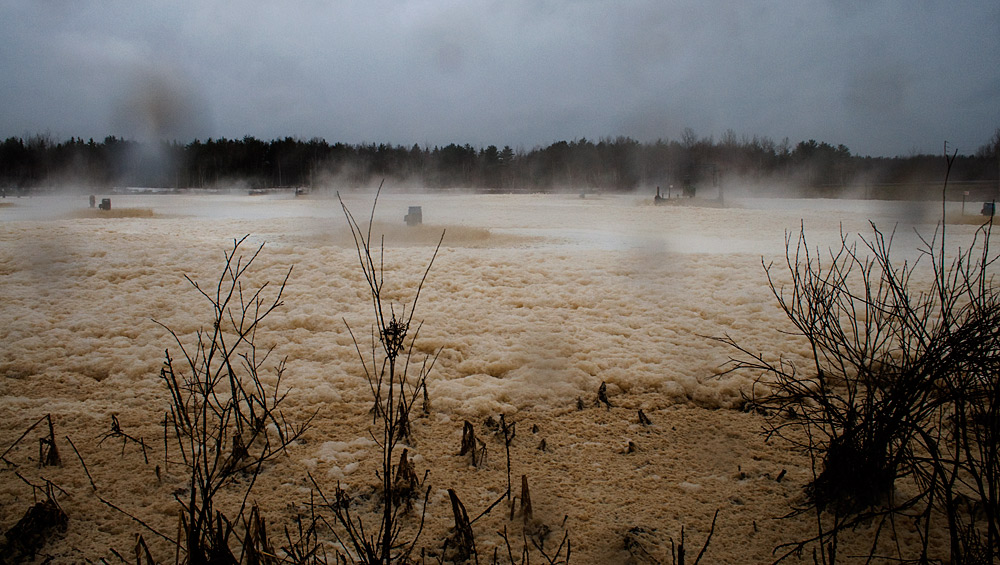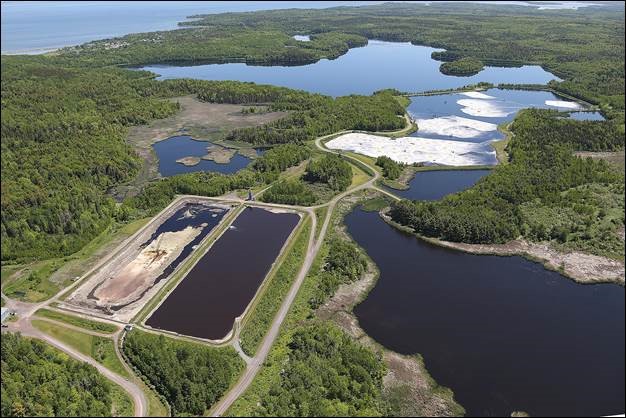Timeline
A chronological history of Boat Harbour, Nova Scotia
Northern Pulp is going to shut down on Jan. 31, putting a stop to the flow of industrial wastewater into Boat Harbour

caption
The aeration lagoon next to the Boat Harbour treatment facility. This photo was taken in 2009.The Northern Pulp mill in Boat Harbour is scheduled to shut down at the end of the month amid concerns about pollution and environmental racism after decades of effluent treatment.
But before 1960, Boat Harbour was an unpolluted tidal estuary on the Northumberland Strait in Pictou County, Nova Scotia. The estuary covered about 142 hectares and was used by the local Pictou Landing First Nation community for fishing, food and recreational purposes. Now, it is used as a waste treatment lagoon for a pulp mill. This began in the 1960s and has provided thousands of jobs.
Now that the mill is close to shutting down, here’s the series of events that led to this point:
1964-1986
- In 1964, the Scott Paper Company announces it wants to build a pulp mill at Abercrombie Point, Nova Scotia. It says the mill will discharge about 25 million gallons of effluent daily. The province agrees to supply clean water to the mill, adding it will provide a place for the mill to discharge its effluent.
- In 1965, John Seaman Bates, chairman of both the Nova Scotia and New Brunswick water authorities, proposes Boat Harbour be used as a waste treatment plant. He claims it will protect Pictou County from further pollution. Pictou Landing First Nation is told the impact will be minimal and was persuaded to accept $60,000 for the loss of their rights to Boat Harbour. That amount is estimated as equal to $480,357.14 in 2019.
- In 1966, a Truro engineer estimates a cost of $95,000 to switch Boat Harbour from a natural lagoon into a waste treatment lagoon.
- In 1967, the Scott Paper mill is up and operating. It receives millions of litres of waste daily.
- In 1968, Pictou Landing occupants make complaints about pollution from the effluent plant. They say it affects their health.
- Two years later, in 1970, the provincial water commission hires the Montreal-based company Rust Consultants to investigate the Boat Harbour complaints. They say the Scott Paper mill needs to be upgraded, and that it needs to add aerators. The province signs a 25-year supply and waste treatment agreement with Scott Paper.
- In 1986, Pictou Landing’s chief files a lawsuit against the federal government for using Boat Harbour for waste and neglecting the health of their people.
1990-1995
- In 1990, several dead fish are reported below waste outfall from Boat Harbour.
- In the early 1990s, the province was pressured by complaints from Pictou Landing occupants to fix Boat Harbour. It employs Jacques Whitford and Beak Consultants to research ideas around how to handle the mill’s waste.
- In July 1993, the federal government signs a $35 million out-of-court settlement with Pictou Landing First Nation. A month later, the consultants propose five options to fix Boat Harbour’s problem. One was opening Boat Harbour to the strait for $30,000 and another was constructing a new treatment facility at an estimated cost of $82 million. The province chose to pipe treated waste from the first lagoon two kilometres into the Northumberland Strait, where it would be mixed into the seawater.
- In 1995, Kimberly-Clark Corporation acquires the mill. The province promises to shut down Boat Harbour by 2005. The province also promises it would pay the environmental liability cost for the lagoon.
2001-2009
- In 2001, Pictou Landing signs a memorandum of understanding with Kimberly-Clark allowing the company to continue using the lagoon while Pictou Landing is financially compensated.
- In 2002, the province extends the lease of Boat Harbour until 2030.
- In 2003, the Nova Scotia government submits an assessment of plans documents to the federal government to reopen Boat Harbour to the strait. In 2004, Neenah Paper takes over ownership of the mill.
- In 2005, consultants say reopening Boat Harbour could make the lagoon eutrophic, a term used to describe a body of water experiencing a significant increase in algae growth.
- In 2006, Pictou Landing First Nation and Neenah Paper modify the memorandum of understanding and set 2008 as a new cleanup deadline.
- In June 2008, Northern Pulp takes ownership of the mill. The license for Northern Pulp to discharge waste to Boat Harbour expires but is renewed on a monthly basis. Province promises not to extend it beyond Dec. 31, 2008 without consulting Pictou Landing.
- In March 2009, the First Nation cautions the province about further discharge without their approval. It says the action will be perceived as a violation of its constitutional rights. First Nation council members begin negotiating with the province and Northern Pulp.
- Meetings are placed on hold because of a June 2009 provincial election. Meetings don’t resume until September 2009.

caption
An aerial photo taken of the Boat Harbour tidal estuary.2010
- In March, the Nova Scotia government loans $75 million to Northern Pulp to purchase 475,000 acres of forest land from previous owner Neenah Paper. The government states the deal was made to protect jobs and support the Pictou County economy.
- In April, Pictou Landing First Nation requests the government end Northern Pulp’s licence by June. June passes without the termination.
- In September, Pictou Landing First Nation launches a lawsuit against the provincial government and Northern Pulp, demanding they build a new effluent treatment facility and clean Boat Harbour.
2011
- In October, the Halifax Media Co-op reports the Nova Scotia government drafted an offer called the “capacity building agreement” of $3 million to Pictou Landing to postpone their lawsuit, with the stipulation that they do not obstruct wastewater dumping for two years, and that the money not be used to fund their lawsuit.
- In January, the federal government grants $28 million to Northern Pulp to fund better environmental practices at the mill.
- In March, B.C.-based company Paper Excellence buys Northern Resources, Northern Pulp’s parent company.
2012
- In January, Pictou Landing community members vote 90 per cent against the $3 million capacity building agreement, as reported in a master’s thesis by Ella Bennett.
2013
- Northern Pulp receives orders from the Nova Scotia Department of Environment in March and November to cut air pollution and the smell of sulfur.
- In April, the province lends Northern Pulp a $14.7 million repayable loan and a $2.5 million forgivable loan to improve air quality and create jobs.
2014
- In June, The Chronicle Herald reports a pipeline has been leaking untreated effluent into a wetland. Later that day, Northern Pulp releases a statement acknowledging the leak. The mill shuts down and Pictou Landing First Nation creates a blockade to the damaged pipeline. The protest ends after the Nova Scotia government issues an order stating that if Northern Pulp does not cut their emissions to the mandated standards, they will be shut down in May 2015.
2015
- In May, the Boat Harbour Act is passed by Nova Scotia. This states the facility must cease the reception and treatment of effluent by Jan. 31, 2020, shortening their previous lease which ran until 2030.
2017
- In September, Northern Pulp qualifies for an environmental assessment of their proposed plans for a new wastewater treatment facility. These plans can be approved, denied, or have more information requested by the provincial environment minister. The proposed facility will process mill wastewater with a sludge treatment facility, then send effluent through an underwater pipeline into the Northumberland Strait.
2018
- In July, hundreds gather in Pictou County for an air and land protest against the newly proposed pipeline.
- In October, a survey boat mapping Northern Pulp’s potential pipeline is blocked by fishermen and forced back to shore.
- In October, Northern Pulp confirms to media that a pipe has been leaking effluent into a wetland. It’s the same pipeline that broke in 2014. They claim that the leak was small and due to outdated technology.
2019
- In March, provincial Environment Minister Margaret Miller does not approve new effluent treatment facility, requesting more information on the environmental impact.
- In May, the federal government commits $100 million to fund a remediation project at Boat Harbour.
- In October, Northern Pulp’s focus report detailing more information requested by the government is made available to the public.
- In December, federal Environment and Climate Change Minister Jonathan Wilkinson decides not to give the Northern Pulp project a federal impact assessment, leaving the decision on a new facility to the Nova Scotia government.
- Later that month, Nova Scotia’s environment minister Gordon Wilson says the government needs more information than the focus report provided, again withholding approval on a new facility. Wilson says scientific evidence of the potential impact is unsatisfactory, and the project will require an environmental assessment report. Northern Pulp has up to two years to submit this report, and after that, the provincial government has up to 285 days to evaluate it and make a decision.
- Days later, Premier Stephen McNeil announces there will be no extension to the Jan. 31, 2020 closure date set in the Boat Harbour Act. He also announces a $50 million transition fund to aid industry workers affected by the closure.

caption
Premier Stephen McNeil says that no new effluent will enter Boat Harbour after Jan. 31.2020
- In January, Northern Pulp says it intends to proceed with the environmental impact assessment of its proposed treatment facility. That day, McNeil announces boiler wastewater will continue to flow into Boat Harbour until April 30 in order to heat pipes through the winter to prevent them from freezing and bursting, which could cause more damage.
About the author
Michael Trombetta
Michael is a student writer at King's College. He's an English literature graduate of Ryerson University. Interested in people, our environment,...
Seyitan Moritiwon
Seyitan is a journalism student at the University of King's College. She hung her lab coat after her degree in microbiology to start a career...

J
JNC
T
Thomas Joseph power
r
robert snow
N
Nick Cantar
r
robert snow
J
Joan Baxter